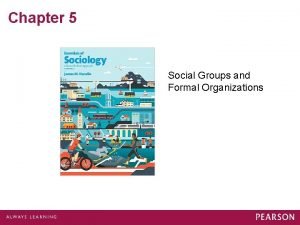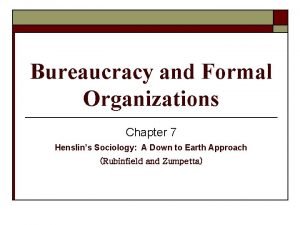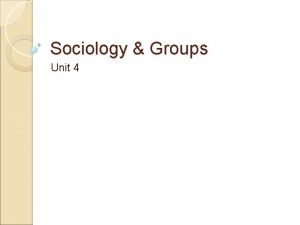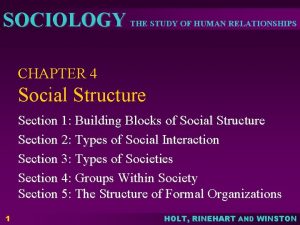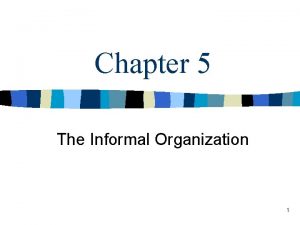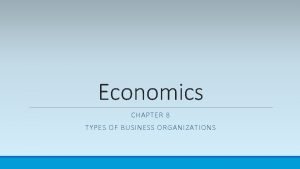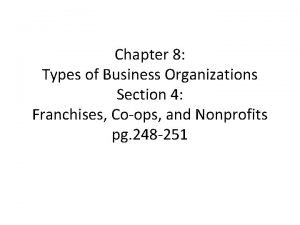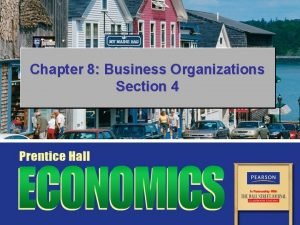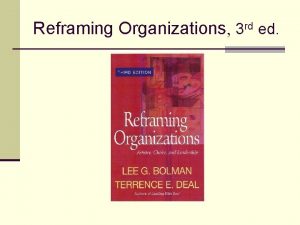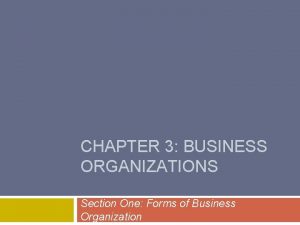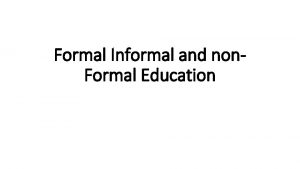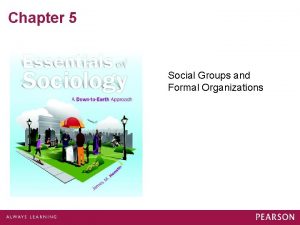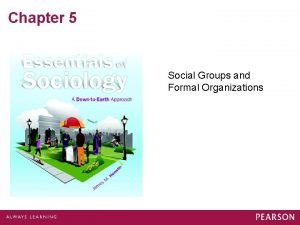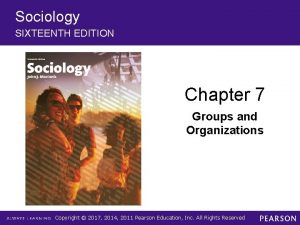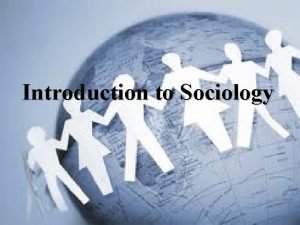SOCIOLOGY CHAPTER 6 Groups and Formal Organizations What



















- Slides: 19

SOCIOLOGY: CHAPTER 6 Groups and Formal Organizations

What is a group? Group: at least two people who have one or more goals in common & share commons ways of thinking and behaving Social Category: people who share a social characteristic Social Aggregate: people temporarily in the same place at the same time

Primary Group Primary group are people who are emotionally close, know each other well, and seek one another’s company Primary relationships: interactions that are intimate, personal, caring, and fulfilling Small size Face to face contact Continuous contact Proper social environment

Function of Primary Groups Emotional support Socialization Encourage conformity

Secondary Groups Secondary group: people who share only part of their lives while focusing on a goal or task Secondary relationships: impersonal interactions involving limited parts of personalities Page

In-groups vs. Out-groups In-group: exclusive group demanding intense loyalty Out group: group targeted by an in-group for opposition, antagonism, or competition In-crowd and Social Cruelty

Reference group Reference groups are used for self-evaluation and the formation of attitudes, values, beliefs, and norms Can be positive and negative

Social Network Social Network: web of social relationships that join a person to other people and groups “Networking”

Group Social Interaction Cooperation Conflict Social Exchange Coercion Conformity

Cooperation Individuals or groups combine their efforts to reach a goal Usually occurs when reaching a goal demands the best use of limited resources/efforts Examples: people surviving after a natural disaster, families dividing household duties

Conflict Interaction aimed at defeating an opponent— groups against each other War, sports games, hate groups Society is benefited by conflict Unites people who are on the same side Draws attention to social inequalities Changes norms, values, beliefs which allows society to change/prosper

Social Exchange Voluntary action performed in the expectation of getting a reward in return “I’ll scratch your back if you scratch mine” “What’s in it for me? ” Can you think of any examples? ?

Coercion Interaction which individuals or groups are forced to behave in a particular way Opposite of social exchange Examples: POW reveal info, government enforce laws through legal punishment, parents control behavior of their children by taking away privileges

Conformity Behavior that matches group expectations Uniformity, predictability, and orderliness Groupthink is self-deceptive thinking that is based on conformity to group beliefs, and created by group pressure to conform Cartoon p. 185 Bay of Pigs Challenger explosion

Groupthink

Formal Organizations Group deliberately created to achieve one or more long term goal Ex. Colleges, corporations, hospitals, government agencies Most formal organizations are bureaucratic Bureaucracy is a formal organization based on rationality and efficiency Examples: the U. S. government, school district, DMV High level of conformity and often delays & frustration on levels of customers

5 Major Characteristics of Bureaucracies Division of labor based on principle of specialization A hierarchy of authority Power: control behavior of others Authority: legitimate or socially approved use of power System of rules and procedures Written records of work & activities Promotion on the basis of merit & qualifications

Start planning and start studying… EO 2 over Chapters 3, 4, 5, 6, AND 7 will be next week – Tuesday March 5 Start looking over your notes and vocabulary so you will be prepared next week Your folders (vocabulary, graphic organizers, and study guide for chapters 3, 4, 5, 6, 7) is also due next week on Tuesday. 60 points

Terms to know for EO 2 Values Sanctions/social sanctions Ethnocentrism Socialization Looking glass self Reference group Master status/ascribed & achieved status Industrial society features Primary groups Formal organization Labeling Theory
 Formal groups fulfill both and functions in organizations.
Formal groups fulfill both and functions in organizations. Social groups and formal organizations
Social groups and formal organizations Formal organizations sociology
Formal organizations sociology How are ethnic groups and religious groups related
How are ethnic groups and religious groups related Social group examples
Social group examples Types of social groups in sociology
Types of social groups in sociology Bureaucratic inertia
Bureaucratic inertia Formal and informal group in sociology
Formal and informal group in sociology Formal and informal groups
Formal and informal groups Examples of task groups
Examples of task groups Chapter 1 introduction to management
Chapter 1 introduction to management Chapter 3 information systems organizations and strategy
Chapter 3 information systems organizations and strategy Formal group types
Formal group types Organizational behavior chapter 6
Organizational behavior chapter 6 Chapter 8 types of business organizations
Chapter 8 types of business organizations Chapter 8 section 4 other organizations
Chapter 8 section 4 other organizations Chapter 8 section 4 other organizations
Chapter 8 section 4 other organizations Reframing organizations chapter 3 summary
Reframing organizations chapter 3 summary Chapter 3 business organizations
Chapter 3 business organizations Informal curriculum
Informal curriculum

